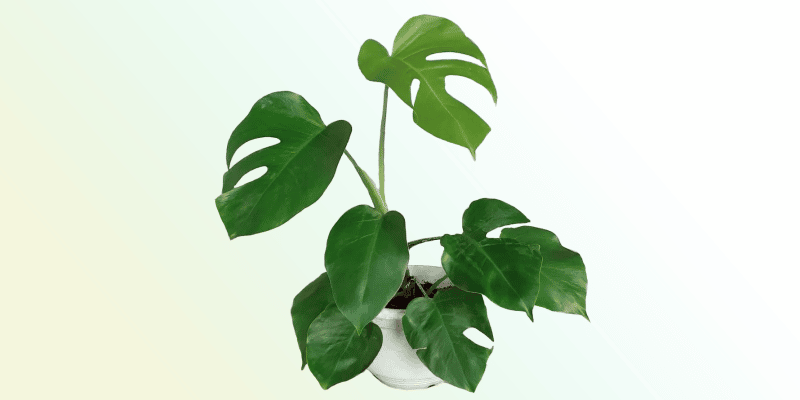Monstera borsigiana is an easy-to-care-for climbing tropical plant that has one of my favorite variations (the ‘albo‘), with stunning white variegated leaves.
We’ll cover how to take care of this Monstera plant, the most common issues that come up, and how to propagate stem cuttings in a few different ways.
(There’s also some confusion on the Monstera Deliciosa vs Borsigiana differences too, so we’ll try to clear that up.)
Table of Contents
Monstera Borsigiana Care Guide
History, habitat, and characteristics
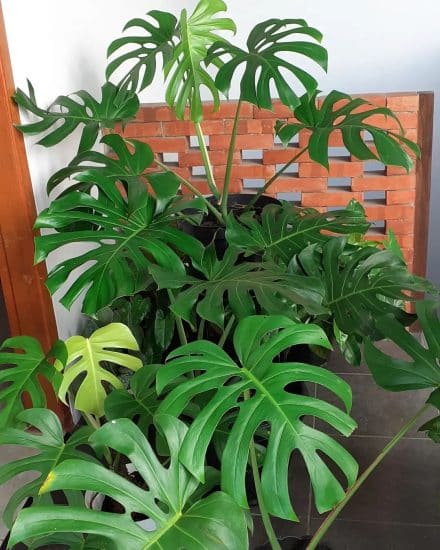
Monstera borsigiana can range from a relatively tame indoor plant to an adventurous climber in the wild with the ability to climb the trees of southern Mexico beyond 50 feet in the air.
Its lush, dark green foliage stands out in any home, and its leaves boast an unmistakable Swiss Cheese-like appearance, giving the plant its cute name.
Monstera plants love to climb, so consider providing a trellis or even a small ladder.
It’s impossible to discuss this plant without going into the stunning variegated varieties available. You’ll see them featured throughout this article too.
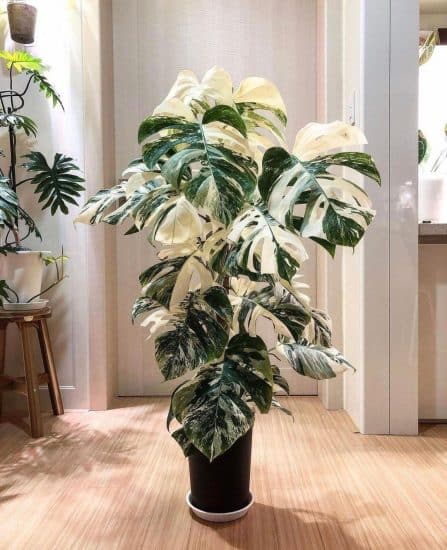
Varieties
- Monstera borsigiana aurea has dark green leaves with radiant gold yellow variegated leaves.
- Monstera borsigiana albo variegata is a rare mutation: it has contrasting white stripes of variegation and sometimes completely white leaves. Each of these plants is unique, so if you find one you like, make sure to grab it (or a cutting!)
- Monstera borsigiana variegata – instead of white, this variegated monstera has light green and yellow spots of color.
Monstera Borsigiana vs Monstera Deliciosa
At first glance, it’s pretty easy to confuse these two plants. Both are avid climbers, found in similar places, with overlapping histories, names, taxonomies… the list goes on. And when we say first glance, both plants look incredibly similar. But there is a small difference, and it’s found in the geniculum.
A geniculum is typically found in climbing plants, and you can think of it as a joint (like the knee) that allows for flexible movement as they climb. You can also find these in plants that are very stimuli sensitive (in that their leaves/stems move in response to light, touch, or certain other plants).
With Monstera borsigiana, you’ll tend to notice a straighter geniculum, and with Monstera deliciosa, it’s a bit more bent and flexible.
So, are there other differences between these two plants?
Not really!
If you consult the official literature, Monstera borsigiana is only listed as a heterotypic synonym, meaning it’s not sufficiently genetically distinct to be classified under its own species.
Now we’ll continue our Monstera borsigiana care guide, which, as you now know, can help you take care of a Monstera deliciosa as well.
As they say: time is a flat circle and there is nothing new under the sun. Speaking of sun…
Light
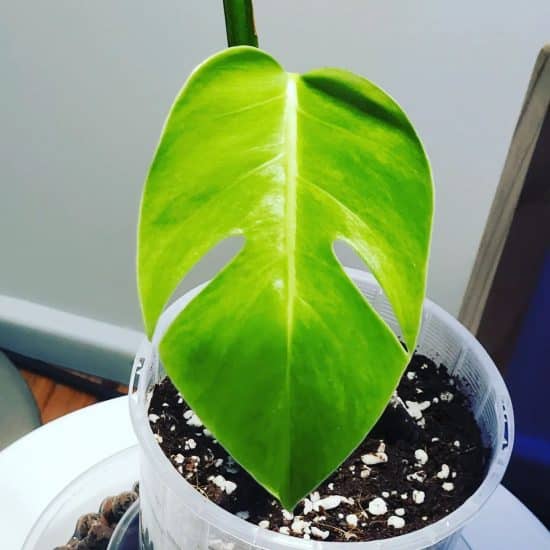
The Monstera borsigiana plant loves bright, indirect light. Depending on the direction of the window, the ideal amount of light can vary. For windows facing north or east, the monstera should be placed a few feet away from the window.
South and west-facing windows tend to have stronger, hotter sunlight, so it’s best to keep the plant further away to protect it from scorching. If needed, you can also use sheer curtains or blinds to soften the light.
It’s an open question among botanists and researchers as to why the leaves of Monstera borsigiana are fenestrated. It’s believed to provide an evolutionary advantage in adverse conditions. However, opinions are split on whether the hole-y leaves provide resistance when placed under heavy shear force, such as the windy and rainy conditions in a thunderstorm, or if they allow light to filter down past them to their neighbors underneath.
Hopefully, your indoor garden doesn’t have too many thunderstorms, but you can take advantage of the fenestration to filter light to other more light-sensitive tropical plants behind, including variegated Monstera species that really thrive under indirect light.
If you notice the leaves turning pale and dull, the plant may not be getting enough light. Try to slowly move the monstera closer to a window until you find the best spot for your plant.
Too much light can be detrimental as well, so keep an eye out for yellow, dry, and wrinkled leaves as a sign of too much sun exposure. In this case, move the plant to an area with more shade.
With a variegated Monstera borsigiana, you’ll also want to look out for your leaves turning completely green. If you notice this, it’s a sure sign that your plant isn’t receiving enough light, as it produces more chlorophyll to make up for its dim condition.
Lighting summary:
- Place Monstera borsigiana in a bright spot that is 2-3 ft from an East or North-facing window with at least 6 hours of light per day, using sheer curtains to filter sunlight
- Monitor the variegation on the leaves for signs of too much or too little light – if your leaves are turning green, turn up those lights.
- Rotate your plant monthly to give an even amount of sunlight to different parts of the plant.
Water
Monstera borsigiana is actually pretty easy to water, and it’s all about finding that happy balance: don’t worry, this plant is opinionated and will happily show you what it likes on its leaves.
The goal is almost always to evenly saturate your soil with water and then give it an opportunity to really dry out. Consider the finger test: you can probably guess how this works without an explanation!
Take a finger and check the first inch or two of the soil. If it feels damp, you can hold off on watering. If it’s dry, it’s time to give your Monstera borsigiana a thorough drink.
Watering is a good time to check on the general health of your plant and take care of any pruning. Underwatering can cause brown tips on leaves, wilting, or curling leaves, while overwatering can cause yellow leaves and waterlogged soil.
Tips for watering your Monstera borsigiana:
- Test soil moisture levels with a finger. 1-2 inches down should give you an indication whether your Monstera needs water or not.
- Water until water comes out of the bottom drainage holes, then let it be fully absorbed for five minutes.
- Check leaf condition as a sign of overwatering (yellow/dropped leaves) or underwatering (curled/wrinkled leaves).
Temperature and humidity
Ever wonder why spas have so many plants? Other than providing a bit of tranquility, it’s close to the optimal environment for many of these tropical species. And while a spa trip can be a nice bit of relaxation for us, living in one could prove difficult.
(But don’t worry, we have a few tips for keeping that humidity high without feeling like you need to open a window.)
Temperature: The sweet spot for Monstera Borsigiana is a warm 65-80°F. Make sure to keep it away from air vents, drafty windows, fans, and sources of extreme heat.
Humidity: The Swiss Cheese Plant loves the moist air found in the tropics, so make sure to recreate that in your home, but local to your plant. To increase humidity levels, consider grouping your plants together, using a pebble tray, or misting the leaves occasionally with a spray bottle — just try to avoid any dust build-up by wiping down periodically with a damp cloth.
Tips:
- Keep the plant away from drafts, like entryways or back doors.
- Increase humidity with a humidifier or by placing the pot on a shallow tray filled with pebbles and water.
Soil and planting
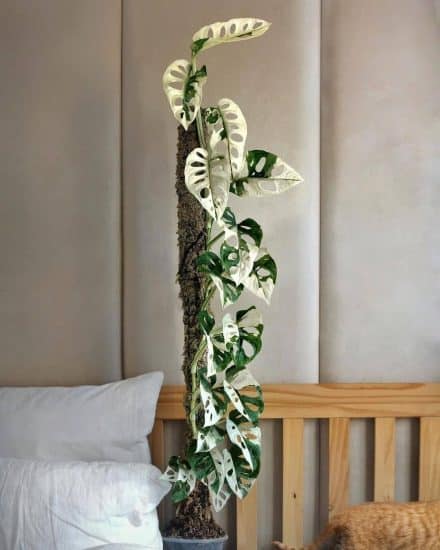
Monstera borsigiana prefers well-draining soil with plenty of nutrients. An ideal soil mix for this plant would incorporate these components:
- Potting mix – your essential base that provides structure, nutrients, and an anchor for the plant’s roots
- Perlite – adds aeration and enhances drainage
- Sphagnum moss – helps keep the soil moist and provides structure
- Optional: LECA – helps create air pockets for soil aeration and water drainage
Like most houseplants, Monstera borsigiana appreciates occasional liquid fertilizer throughout its growing season to provide an extra boost of micronutrients and nitrogen. However, it’s important not to overdo it, as too much fertilizer can hurt its delicate root system.
Start with a 50% dilution of a balanced liquid houseplant fertilizer once a month in spring and summer, and reduce to every two months in the fall.
When repotting a mature Monstera borsigiana, size matters. Choose a wide and shallow container, preferably a rectangular one, with drainage holes.
Gently extract the root ball from its old pot, place it into the new one, and fill in with fresh potting mix. Add a post to the center of the pot to help keep the plant upright as it grows and climbs, then water the soil generously.
Propagation guide
Propagating Monstera Borsigiana is a fun and easy way to grow more of these lovely houseplants. All you need is a healthy stem with a couple of leaves, a sharp, clean knife, some rooting hormone (optional), potting soil, a glass jar, and some patience. Follow these steps to have a new baby Monstera borsigiana in no time:
- Cut off a section of the stem that includes at least two leaf nodes. Be careful when making your cut, as this will be the source of new roots.
- Gently remove any leaves from the lower half of the stem nodes. This area will be in contact with the water or soil when you propagate, and leaving the leaves could cause rot.
- Create a moist environment in which to root the cutting. You can either place the cutting in a container filled with water (pretty moist, right?), in soil, or sphagnum moss.
- Place the cuttings in an area with bright light, but not direct sunlight, and keep it at a consistent temperature of around 65-75° F.
- Be patient, as it can take anywhere from 2-4 weeks for new roots to grow. With adequate light, warmth, and moisture, you should see new foliage (and roots) start appearing.
Propagating in water is great for beginners, since it’s easy to see how well your stem cutting is doing throughout the process without needing a rooting medium like soil or sphagnum moss. We always loved to do this as an activity with the kids.
While aerial roots aren’t what you’re looking for as your main source of propagation, they can be included as they often speed up the process. They help your new baby plants mimic how the mother plant climbs and attaches to a structure.
Enjoy your new plant babies!
Common issues
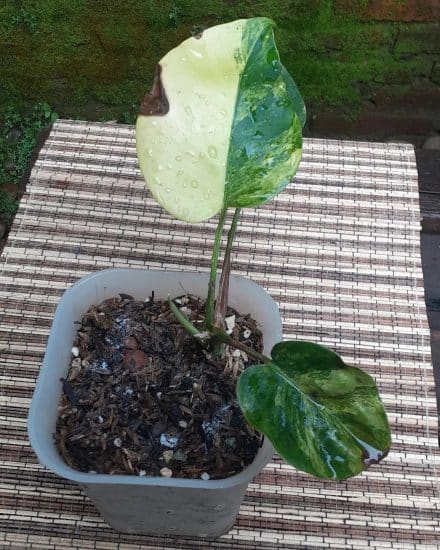
No matter how well we care for our plants, it’s inevitable that problems will develop. In this section, we’ll cover the most common issues we see with Monstera borsigiana.
Brown and Yellow Leaves
Monstera Borsigiana plant leaves turning brown or yellow is a clear sign of a distressed plant. First, evaluate their texture: if they’re thick and drooping, this could be overwatering. If they’re crispy and brown around the edges or tips, this can be too much fertilizer or light.
Lack of holes or fenestrated leaves
It is normal for very young Monstera Borsigiana Aurea plants not to have any slits or fenestrations yet. The signature slits will start to form as your plant matures. Support your Monstera’s growth by keeping it in bright indirect sunlight and supplying it with adequate nutrition.
Diseases and pests
Any diseases or pests that you find can often be indications of deeper problems with your Monstera borsigiana care routine. So take this as an opportunity not to just resolve the obvious symptoms but evaluate the major ingredients you supply to your plant: light, water, humidity, temperature, and soil.
Root Rot
Root rot is incredibly common for Monstera Borsigiana plants, and really all indoor plants. It’s caused by plant roots sitting in moist soil (or standing water, even worse) for too long. The plant weakens and the root system becomes damaged, leading to reduced growth, wilting, and then rot.
Phytophthora, the pathogen responsible, is actually present in almost all soil, but only becomes an issue when when the moisture levels remain consistently high. The Phytophthora spores will begin to spread along the entire root system, eventually causing the roots to turn mushy. This can lead to a cascade of further issues, such as nutrient deficiencies, stunted growth, and disease spread.
You’ll need to cut off any affected roots and repot.
To avoid root rot:
- Ensure proper drainage when watering the plant.
- The soil should never be completely saturated — the water should freely drain out of the pot through its drainage holes.
- Adequate airflow is needed around the roots of the plant. Provide this with a light and well-draining soil mix. See our guide above for materials you can add to increase aeration and drainage.
Fungus
Fungal infections can occur on Monstera borsigiana plants due to high relative humidity, lack of airflow, or overwatering.
Symptoms of a fungal infection include gray or white spots on the leaves, yellowing of the leaves, and wilting of the leaves. An anti-fungal plant spray can help to treat a fungal infection after resolving your moisture issues.
Pests
Spider mites and mealybugs are common problems for Monstera borsigiana plants. If you notice small white bugs or webs on the underside of the leaves or around the stems, isolate the plant from the others and treat it with cold soapy water or an insecticidal soap solution. If you have access to it, we recommend neem oil as well.
Powdery Mildew
Powdery mildew appears as a white, velvety powdery substance on the leaves or stem, and can spread rapidly over the plant if not treated. These plants love humidity and so does powdery mildew, so it’s important to keep your plant in a well-ventilated room with enough air circulation.
If you do notice it making an appearance you’ll want to treat it right away with a plant fungicide. Make sure to cover the entire plant and underneath its leaves. We also recommend pruning off any affected parts of the plant as soon as you notice them, as this will stop the fungal spores from spreading. Sterilize your pruning tools with rubbing alcohol before and after use.
Conclusion
Monstera borsigiana may look like swiss cheese, but unlike the culinary delicacy, it adds a delicate grace to any room it’s featured in.
While plant enthusiasts may love the ‘Albo’ variation, we’re here for that plain Borsigiana.
Okay, jokes aside, this plant is so easy to care for and a beautiful Monstera example. Whether it’s climbing on a trellis or pruned to grow wide, we think you’ll appreciate every leaf.
FAQ
Are variegated Monstera borsigiana harder to care for?
Variegated plants often are more sensitive to light, but not necessarily harder to care for. In some ways, they can be a bit easier to maintain because you can more quickly notice issues as their color changes.
Monstera borsigiana ‘albo’ photosynthesize less effectively than their non-variegated counterparts, but this doesn’t mean they like direct light. If you notice a slower growth rate or leaf coloration issues with your variegated version, I’d first check the lighting. With less chlorophyll, they need just a little bit of assistance.
Can you propagate from Monstera borsigiana seeds?
It’s possible, but exceptionally difficult. The growing conditions for Monstera borsigiana already feature high humidity, but germination requires even higher levels, and there’s a small window of appropriate temp/humidity. We recommend using the stem cuttings method instead, as this produces durable roots that should be visible within a few weeks.
Which plant is the ‘Swiss Cheese Plant?’
Both Monstera deliciosa and Monstera borsigiana have this name, and in fact, they’re the same species. The holes and fenestration in the leaves of mature plants give them a similar look.
How fast does a Monstera Borsigiana grow?
Depends on growing conditions and initial leaf size, but in their natural habitat, they grow quickly beginning in early spring. Indoors, we’re more concerned with healthy growth and creating an environment where they can produce strong, resilient roots.
How can I cut or prune my Monstera Borsigiana?
We recommend that any cuttings take place during the growing season (spring, summer) and that you use a sharp pair of shears. Use this as an opportunity to remove any damaged leaves, and it’s also fine to cut back aerial roots (they won’t stop growing). Trim to the stem.

